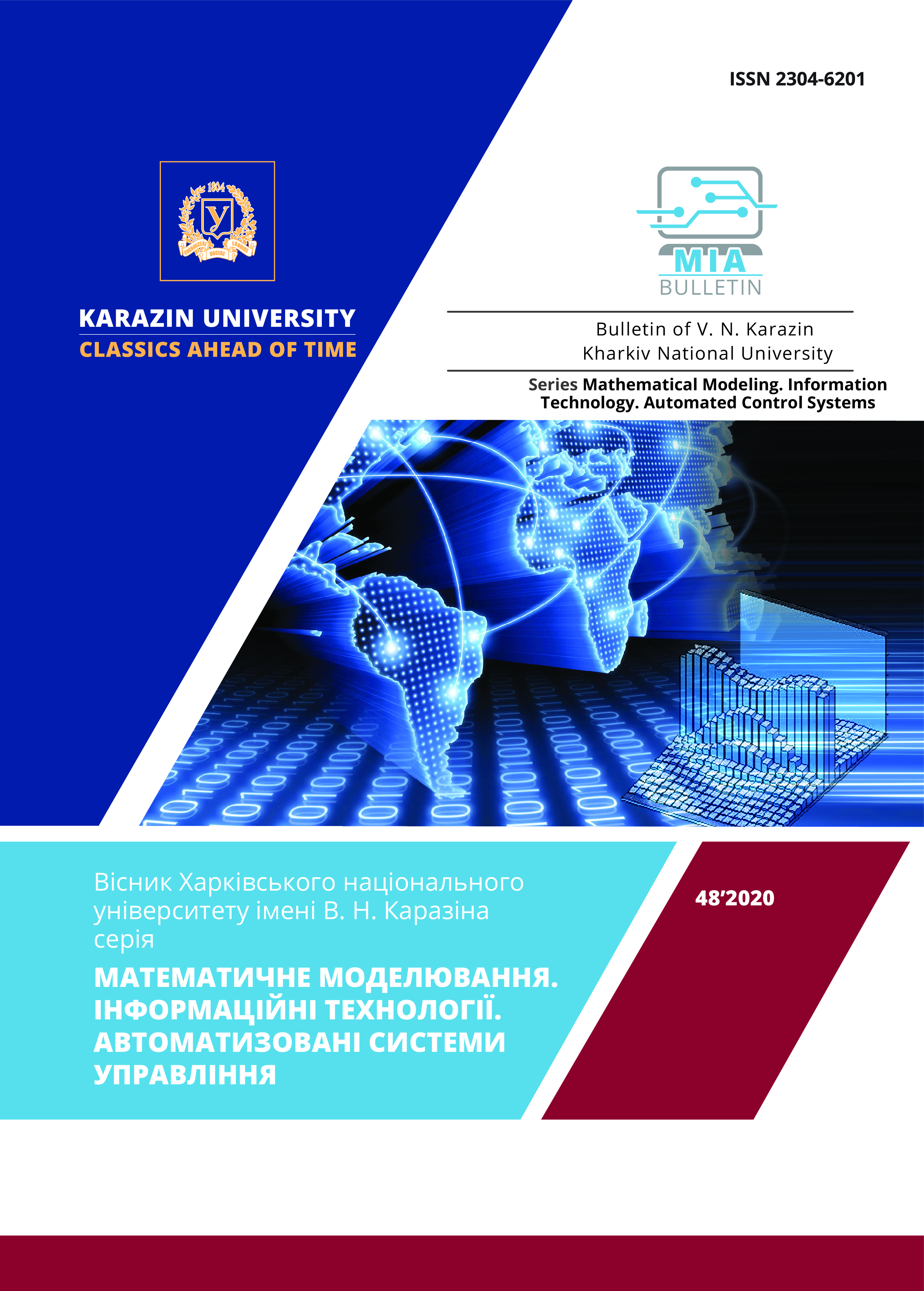Development of an IoT network infrastructure based on a sensor network of distributed sensors for measuring radiation pollution using a multi-level architecture
Abstract
Approaches to creating a network infrastructure based on a network of distributed sensors for radiation monitoring of environmental pollution have been developed in the article. Fundamental solutions IoT is characterized as integral part of the peoples’ live not only in Ukraine but a whole world. The article analyzes and develops schematic diagram and unified approaches to building a full-fledged system of distributed sensors that can be wirelessly connected to each other. By using cloud services, a new level of interaction between the user and the application has been reached. Autonomous network management should provide for various aspects such as: self-management, automatic configuration, automatic troubleshooting, as well as power management. These prerequisites are essential for this set of devices. The system is responsible for communication between the user and applications, and above all for creating secure communication channels, because the issue of cybersecurity is of extreme importance and data breaches can cause environmental risks and huge expenses. The article examines the ability to respond to location, provide communication between devices and users and meet the security needs of the equipment installation. Individual parts of the IoT system, which usually work automatically, allow authorized persons to provide the necessary configurations and measurements. The multilevel nature of IoT for managing transmission, reception, and data processing has been considered. The article supplements previous articles on the topic of full-fledged sensor network architecture where the modern microcontrollers are used. Using modern protocols makes it possible to present this system on the world market. Communication networks transmit data received from connected devices, as well as program instructions to other parts of the system; therefore providing opportunities for reliable and efficient data transmission. The IoT network infrastructure can be implemented through existing networks and data exchange protocols, such as TCP/IP, and on currently developed networks, such as next-generation networks (NGN). The latest approaches to system management are applied.
Downloads
References
/References
Ridozub, O., Terokhin, V., Stervoyedov, N., Fomin, S.. Touch node for a wireless radiation monitoring network. Bulletin of V. N. Karazin Kharkiv National University, Series " mathematical modeling. Information technologies. Automated control systems", 2019, 44, 88-93c. https://periodicals.karazin.ua/mia/index [In Ukraine]
Azhazha V. M., Kutny V. E., Rybka A.V., Davydov L. N., Shlyakhov I. N., Zakharchenko A. A., Kutny D. V., Nakonechny D. V. devices based on CdTe and CdZnTe for technological control and monitoring of the radiation situation at the NPP. 2006, Vol. 2, No. 6, pp. 31-38. http://dspace.nbuv.gov.ua/handle/123456789/113940 [In Russia]
Zakharchenko A. A. modeling of dosimetric properties of gamma radiation detectors based on high-resistance semiconductor devices. Dissertation for the candidate's degree. Fiz. - mat. Nauk. Kharkiv, 2009, pp. 28-31. http://dspace.nbuv.gov.ua/bitstream/handle/123456789/52427/10-Zakharchenko.pdf?sequence
D. Evans the Internet of Things How the next Evolution of the Internet is Changing everything: [electronic resource] / / April 2011, Cisco Internet Business Solutions Group (IBSG), 2016-2020. URL: https://www.cisco.com/c/dam/en_us/about/ac79/docs/innov/IoT_IBSG_0411FINAL.pdf. accessed: 02.08.2020
The Internet of Things (IoT) – essential IoT business guide: [electronic resource] // i-SCOOP. 2017-2020. URL: https://www.i-scoop.eu/internet-of-things-guide/. accessed: 02.08.2020 [In Ukraine]
Ridozub, O., Terokhin, V., Stervoyedov, N., Fomin, S..Development of basic approaches to the creation of hardware and software tools for information systems for radiation monitoring. Bulletin of V. N. Karazin Kharkiv National University, Series " mathematical modeling. Information technologies. Automated control systems", 2020, 46, 82-91c. https://periodicals.karazin.ua/mia/index .[In Ukraine]
China: the world's Largest IoT Market: [electronic resource] // September 2018, MarketingToChina, 2019-2020. URL: https://www.marketingtochina.com/china-world-largest-iot-market/. accessed: 10.09.2020
Internet of Things (IoT) Gateways: [electronic resource] // @geeksforgeeks. 2020. URL: https://www.geeksforgeeks.org/internet-of-things-iot-gateways / accessed: 11.09.2020
K. K Patel, S. M Patel Internet of Things-IOT: Definition, Characteristics, Architecture, Enabling Technologies, Application & Future Challenges // International Journal of Engineering Science and Computing, May 2016 pp. 6122-6131v
Introduction to IoT protocols and types: [electronic resource] // Microcontrollerslab.com, 2013-2020. URL: https://microcontrollerslab.com/iot-protocols-types/. accessed: 12.09.2020
Ridozub, O., Terokhin, V., Stervoyedov, N., Fomin, S.. Сенсорний вузол для бездротової мережі радіаційного моніторингу. Вісник Харківського національного університету імені В.Н. Каразіна, серія «Математичне моделювання. Інформаційні технології. Автоматизовані системи управління», 2019, 44, 88-93с. https://periodicals.karazin.ua/mia/index
Ажажа В.М. Приборы на основе CdTe и CdZnTe для технологического контроля и мониторинга радиационной обстановки на АЭС / В.М. Ажажа, В.Е. Кутний, А.В. Рыбка, Л.Н. Давыдов, И.Н. Шляхов, А.А. Захарченко, Д.В. Кутний, Д.В. Наконечный // Наука та інновації. – 2006. – Т. 2, № 6. – С. 31–38. http://dspace.nbuv.gov.ua/handle/123456789/113940
Захарченко А.А. Моделирование дозиметрических свойств детекторов гамма излучения на основе высокоомных полупроводников. Диссертация на соискание канд. физ. – мат. наук. Харьков,2009 С. 28–31. http://dspace.nbuv.gov.ua/bitstream/handle/123456789/52427/10-Zakharchenko.pdf?sequence=1
D. Evans The Internet of Things How the Next Evolution of the Internet is Changing Everything : [Електронний ресурс] // April 2011, Cisco Internet Business Solutions Group (IBSG), 2016-2020. URL: https://www.cisco.com/c/dam/en_us/about/ac79/docs/innov/IoT_IBSG_0411FINAL.pdf. Дата звернення: 02.08.2020
The Internet of Things (IoT) – essential IoT business guide: [Електронний ресурс] // i-SCOOP. 2017-2020. URL: https://www.i-scoop.eu/internet-of-things-guide/. Дата звернення: 02.08.2020
Ridozub, O., Terokhin, V., Stervoyedov, N., Fomin, S..Розробка основних підходів до створенняапаратно-програмних засобів інформаційних систем радіаційного моніторингу. Вісник Харківського національного університету імені В.Н. Каразіна, серія «Математичне моделювання. Інформаційні технології. Автоматизовані системи управління», 2020, 46, 82-91с. https://periodicals.karazin.ua/mia/index
China: The World Largest IoT Market: [Електронний ресурс] // September 2018, MarketingToChina, 2019-2020. URL: https://www.marketingtochina.com/china-world-largest-iot-market/. Дата звернення: 10.09.2020
Internet of Things (IoT) Gateways: [Електронний ресурс] // @geeksforgeeks. 2020. URL: https://www.geeksforgeeks.org/internet-of-things-iot-gateways/ Дата звернення: 11.09.2020
K. K Patel, S. M Patel Internet of Things-IOT: Definition, Characteristics, Architecture, Enabling Technologies, Application & Future Challenges // International Journal of Engineering Science and Computing, May 2016 с.6122-6131.
Introduction to IoT protocols and types: [Електронний ресурс] // Microcontrollerslab.com, 2013-2020. URL: https://microcontrollerslab.com/iot-protocols-types/. Дата звернення: 12.09.2020




